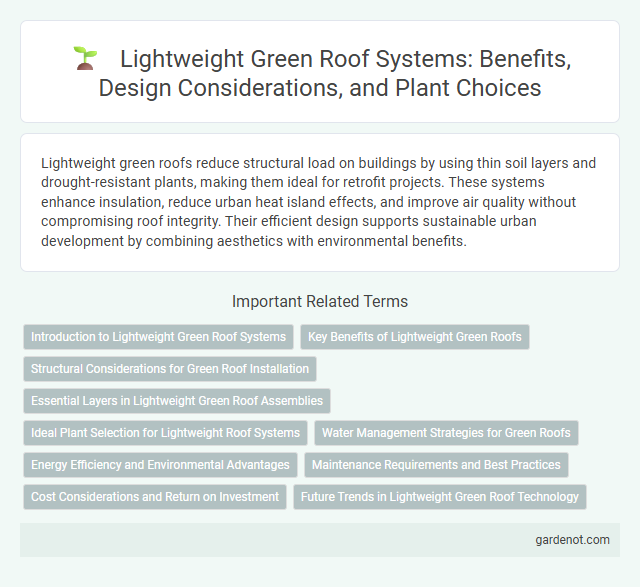Lightweight green roofs reduce structural load on buildings by using thin soil layers and drought-resistant plants, making them ideal for retrofit projects. These systems enhance insulation, reduce urban heat island effects, and improve air quality without compromising roof integrity. Their efficient design supports sustainable urban development by combining aesthetics with environmental benefits.
Introduction to Lightweight Green Roof Systems
Lightweight green roof systems significantly reduce structural load by utilizing advanced materials such as expanded shale, perlite, or lightweight aggregates for the growing medium. These systems are designed for buildings with limited load-bearing capacities while maintaining essential green roof benefits like stormwater management, thermal insulation, and urban heat island mitigation. Innovations in lightweight substrates and modular planting trays optimize installation efficiency and long-term performance in both new and retrofit applications.
Key Benefits of Lightweight Green Roofs
Lightweight green roofs significantly reduce structural load, making them suitable for buildings with load constraints while enhancing thermal insulation and energy efficiency. They promote stormwater management by absorbing rainwater, reducing runoff, and mitigating urban heat island effects. These roofs also improve air quality and increase biodiversity, contributing to sustainable urban environments.
Structural Considerations for Green Roof Installation
Lightweight green roofs require careful structural analysis to ensure building support with minimal added load, typically focusing on materials with low density such as expanded clay or perlite. Engineers assess load-bearing capacity, including live loads from vegetation and water retention, to prevent structural stress or damage. Proper waterproofing and drainage systems are essential to maintain roof integrity and support healthy plant growth while minimizing maintenance.
Essential Layers in Lightweight Green Roof Assemblies
Lightweight green roof assemblies consist of essential layers including a waterproof membrane, root barrier, drainage layer, lightweight growing medium, and vegetation layer designed to minimize structural load while promoting plant growth. The lightweight growing medium is engineered with porous materials like expanded shale or perlite that retain moisture yet reduce weight compared to traditional soils. Proper integration of these layers ensures efficient water retention, drainage, root protection, and thermal insulation critical for the performance and longevity of lightweight green roof systems.
Ideal Plant Selection for Lightweight Roof Systems
Ideal plant selection for lightweight green roof systems emphasizes drought-tolerant, low-maintenance species such as sedums, succulents, and native grasses that thrive with minimal substrate depth and water retention. These plants contribute to reduced structural load while enhancing biodiversity and thermal insulation. Lightweight substrates combined with these resilient species optimize growth performance and long-term sustainability on rooftops with strict load limits.
Water Management Strategies for Green Roofs
Lightweight green roofs incorporate specialized water management strategies that optimize stormwater retention and reduce runoff volume. Advanced layers such as high-porosity substrates and efficient drainage mats enhance water absorption while ensuring rapid drainage to prevent structural overload. These systems improve urban water cycle regulation by maximizing evapotranspiration and delaying peak flow rates during heavy rainfall events.
Energy Efficiency and Environmental Advantages
Lightweight green roofs significantly improve energy efficiency by enhancing insulation, reducing heat transfer, and lowering cooling and heating costs. Their reduced weight allows installation on a wider range of buildings, minimizing structural reinforcement needs and material usage. Environmental advantages include stormwater management, air quality improvement, and biodiversity support, making them sustainable urban infrastructure solutions.
Maintenance Requirements and Best Practices
Lightweight green roofs require minimal maintenance due to their shallow substrate layers and drought-resistant plant species, reducing the need for frequent watering and fertilization. Regular inspection for drainage efficiency and removal of debris prevents root clogging and waterlogging, ensuring optimal plant health and roof longevity. Implementing best practices such as seasonal pruning, monitoring for pests, and replenishing substrate nutrients promotes sustainable performance and maximizes ecological benefits.
Cost Considerations and Return on Investment
Lightweight green roofs reduce structural load, lowering installation costs by minimizing the need for structural reinforcement in buildings. Initial investment varies between $15 to $25 per square foot, with maintenance expenses averaging 10-15% of installation costs annually. Energy savings from improved insulation and extended roof lifespan contribute to a return on investment typically realized within 7 to 10 years.
Future Trends in Lightweight Green Roof Technology
Future trends in lightweight green roof technology emphasize the integration of advanced, porous substrate materials that enhance water retention while reducing overall weight. Innovations in modular panel systems promote easier installation and maintenance, enabling wider adoption across urban environments with structural load constraints. Enhanced sensor-driven irrigation and growth monitoring systems optimize plant health and resource efficiency, aligning with smart building initiatives.
Lightweight green roof Infographic

 gardenot.com
gardenot.com